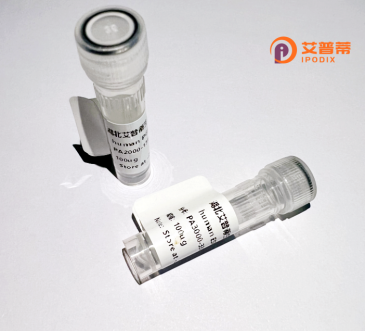
| 纯度 | >90%SDS-PAGE. |
| 种属 | Human |
| 靶点 | ATP6V1C1 |
| Uniprot No | P21283 |
| 内毒素 | < 0.01EU/μg |
| 表达宿主 | E.coli |
| 表达区间 | 2-382aa |
| 氨基酸序列 | TEFWLISAP GEKTCQQTWE KLHAATSKNN NLAVTSKFNI PDLKVGTLDV LVGLSDELAK LDAFVEGVVK KVAQYMADVL EDSKDKVQEN LLANGVDLVT YITRFQWDMA KYPIKQSLKN ISEIIAKGVT QIDNDLKSRA SAYNNLKGNL QNLERKNAGS LLTRSLAEIV KKDDFVLDSE YLVTLLVVVP KLNHNDWIKQ YETLAEMVVP RSSNVLSEDQ DSYLCNVTLF RKAVDDFRHK ARENKFIVRD FQYNEEEMKA DKEEMNRLST DKKKQFGPLV RWLKVNFSEA FIAWIHVKAL RVFVESVLRY GLPVNFQAML LQPNKKTLKK LREVLHELYK HLDSSAAAII DAPMDIPGLN LSQQEYYPYV YYKIDCNLLE FK |
| 分子量 | 43.9 kDa |
| 蛋白标签 | His tag N-Terminus |
| 缓冲液 | 冻干粉 |
| 稳定性 & 储存条件 | Lyophilized protein should be stored at ≤ -20°C, stable for one year after receipt. Reconstituted protein solution can be stored at 2-8°C for 2-7 days. Aliquots of reconstituted samples are stable at ≤ -20°C for 3 months. |
| 复溶 | Always centrifuge tubes before opening.Do not mix by vortex or pipetting. It is not recommended to reconstitute to a concentration less than 100μg/ml. Dissolve the lyophilized protein in distilled water. Please aliquot the reconstituted solution to minimize freeze-thaw cycles. |
以下是关于ATP6V1C1的3篇文献概述,供参考:
1. **文献名称**:*"ATP6V1C1 regulates the cellular sensitivity to cisplatin by interacting with HDAC2"*
**作者**:Zhang Y et al.
**摘要**:研究揭示了ATP6V1C1通过与组蛋白去乙酰化酶HDAC2相互作用,调控DNA损伤修复通路,影响癌细胞对化疗药物顺铂的敏感性。敲除ATP6V1C1可增强顺铂的细胞毒性。
2. **文献名称**:*"Structural and functional insights into the human V-ATPase C subunit"*
**作者**:Toei M et al.
**摘要**:通过冷冻电镜和生化实验解析ATP6V1C1的结构与功能,证明其作为V-ATP酶核心调节亚基,参与质子泵复合体的组装及膜定位,并调控酶活性。
3. **文献名称**:*"ATP6V1C1 promotes osteoclast differentiation and bone resorption via PI3K/AKT signaling"*
**作者**:Zhao H et al.
**摘要**:发现ATP6V1C1在破骨细胞分化中高表达,通过激活PI3K/AKT信号通路促进骨吸收。抑制其表达可减缓骨质疏松症动物模型中的骨质流失。
---
如需文献原文链接或更多领域研究(如肿瘤转移、细胞自噬等),可补充说明研究方向。
ATP6V1C1. a critical subunit of the vacuolar-type (V-type) proton ATPase (V-ATPase) complex, plays a central role in regulating intracellular pH by mediating proton transport across eukaryotic membranes. V-ATPases are multi-subunit complexes composed of a peripheral V1 domain (ATP hydrolysis) and a membrane-integral V0 domain (proton translocation). As part of the V1 sector, ATP6V1C1 (subunit C1) is essential for assembly and enzymatic activity of the holoenzyme, facilitating the coupling of ATP hydrolysis to proton pumping. This ATPase maintains acidic environments in organelles like lysosomes, endosomes, and secretory vesicles, supporting processes such as protein degradation, membrane trafficking, and neurotransmitter release.
Dysregulation of ATP6V1C1 is implicated in diverse pathologies. Overexpression correlates with cancer progression by enhancing tumor cell survival, invasion, and drug resistance through pH-dependent mechanisms. Genetic variants are linked to osteoporosis and renal tubular acidosis. Recombinant human ATP6V1C1 enables mechanistic studies of V-ATPase dysfunction and serves as a tool for drug discovery targeting pH-dependent diseases. Its role in cellular homeostasis and disease underscores its potential as a therapeutic target, particularly in oncology and metabolic disorders. Research continues to explore its isoform-specific functions and regulatory interplay within the V-ATPase complex.
×